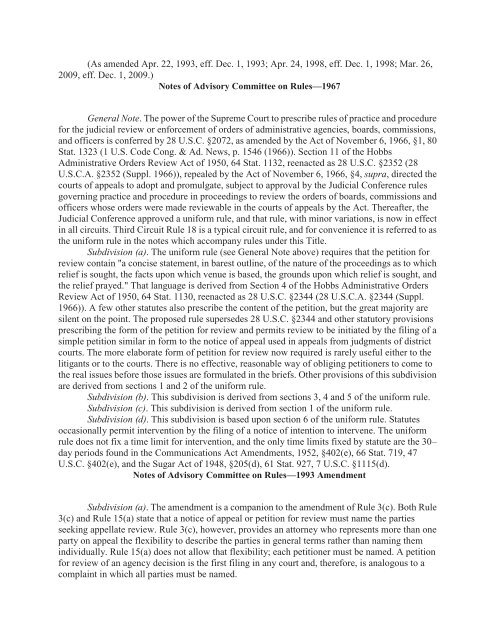Federal Rules of Appellate Procedure 2014-2015, 2014a
Federal Rules of Appellate Procedure 2014-2015, 2014a
Federal Rules of Appellate Procedure 2014-2015, 2014a
Create successful ePaper yourself
Turn your PDF publications into a flip-book with our unique Google optimized e-Paper software.
(As amended Apr. 22, 1993, eff. Dec. 1, 1993; Apr. 24, 1998, eff. Dec. 1, 1998; Mar. 26,<br />
2009, eff. Dec. 1, 2009.)<br />
Notes <strong>of</strong> Advisory Committee on <strong>Rules</strong>—1967<br />
General Note. The power <strong>of</strong> the Supreme Court to prescribe rules <strong>of</strong> practice and procedure<br />
for the judicial review or enforcement <strong>of</strong> orders <strong>of</strong> administrative agencies, boards, commissions,<br />
and <strong>of</strong>ficers is conferred by 28 U.S.C. §2072, as amended by the Act <strong>of</strong> November 6, 1966, §1, 80<br />
Stat. 1323 (1 U.S. Code Cong. & Ad. News, p. 1546 (1966)). Section 11 <strong>of</strong> the Hobbs<br />
Administrative Orders Review Act <strong>of</strong> 1950, 64 Stat. 1132, reenacted as 28 U.S.C. §2352 (28<br />
U.S.C.A. §2352 (Suppl. 1966)), repealed by the Act <strong>of</strong> November 6, 1966, §4, supra, directed the<br />
courts <strong>of</strong> appeals to adopt and promulgate, subject to approval by the Judicial Conference rules<br />
governing practice and procedure in proceedings to review the orders <strong>of</strong> boards, commissions and<br />
<strong>of</strong>ficers whose orders were made reviewable in the courts <strong>of</strong> appeals by the Act. Thereafter, the<br />
Judicial Conference approved a uniform rule, and that rule, with minor variations, is now in effect<br />
in all circuits. Third Circuit Rule 18 is a typical circuit rule, and for convenience it is referred to as<br />
the uniform rule in the notes which accompany rules under this Title.<br />
Subdivision (a). The uniform rule (see General Note above) requires that the petition for<br />
review contain "a concise statement, in barest outline, <strong>of</strong> the nature <strong>of</strong> the proceedings as to which<br />
relief is sought, the facts upon which venue is based, the grounds upon which relief is sought, and<br />
the relief prayed." That language is derived from Section 4 <strong>of</strong> the Hobbs Administrative Orders<br />
Review Act <strong>of</strong> 1950, 64 Stat. 1130, reenacted as 28 U.S.C. §2344 (28 U.S.C.A. §2344 (Suppl.<br />
1966)). A few other statutes also prescribe the content <strong>of</strong> the petition, but the great majority are<br />
silent on the point. The proposed rule supersedes 28 U.S.C. §2344 and other statutory provisions<br />
prescribing the form <strong>of</strong> the petition for review and permits review to be initiated by the filing <strong>of</strong> a<br />
simple petition similar in form to the notice <strong>of</strong> appeal used in appeals from judgments <strong>of</strong> district<br />
courts. The more elaborate form <strong>of</strong> petition for review now required is rarely useful either to the<br />
litigants or to the courts. There is no effective, reasonable way <strong>of</strong> obliging petitioners to come to<br />
the real issues before those issues are formulated in the briefs. Other provisions <strong>of</strong> this subdivision<br />
are derived from sections 1 and 2 <strong>of</strong> the uniform rule.<br />
Subdivision (b). This subdivision is derived from sections 3, 4 and 5 <strong>of</strong> the uniform rule.<br />
Subdivision (c). This subdivision is derived from section 1 <strong>of</strong> the uniform rule.<br />
Subdivision (d). This subdivision is based upon section 6 <strong>of</strong> the uniform rule. Statutes<br />
occasionally permit intervention by the filing <strong>of</strong> a notice <strong>of</strong> intention to intervene. The uniform<br />
rule does not fix a time limit for intervention, and the only time limits fixed by statute are the 30–<br />
day periods found in the Communications Act Amendments, 1952, §402(e), 66 Stat. 719, 47<br />
U.S.C. §402(e), and the Sugar Act <strong>of</strong> 1948, §205(d), 61 Stat. 927, 7 U.S.C. §1115(d).<br />
Notes <strong>of</strong> Advisory Committee on <strong>Rules</strong>—1993 Amendment<br />
Subdivision (a). The amendment is a companion to the amendment <strong>of</strong> Rule 3(c). Both Rule<br />
3(c) and Rule 15(a) state that a notice <strong>of</strong> appeal or petition for review must name the parties<br />
seeking appellate review. Rule 3(c), however, provides an attorney who represents more than one<br />
party on appeal the flexibility to describe the parties in general terms rather than naming them<br />
individually. Rule 15(a) does not allow that flexibility; each petitioner must be named. A petition<br />
for review <strong>of</strong> an agency decision is the first filing in any court and, therefore, is analogous to a<br />
complaint in which all parties must be named.


















